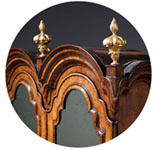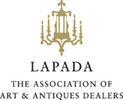17th Century William and Mary Kingwood Strongbox, with Gilt Brass
SOLD
Request Information
Follow Us
17th Century William and Mary Kingwood Strongbox, with Gilt Brass
A 17th century William and Mary Kingwood strongbox, with gilt brass straps. This strongbox has to be one of the most charming and certainly the smallest example we have encountered, at just 17.5 cm high, 28 cm wide and 18 cm deep. A strongbox of similar merit form and style resides at Burghley House in ‘The 1st George State Room.
The box appears decorative, but it was also very difficult to break open or steal. It has a strong lock to the centre and two bolts concealed in the sides, so that it could be screwed down into floorboards if necessary or that of a horse-drawn carriage. Strong-boxes veneered in oysters of Princewood such as this were luxury objects.
The Cabinet-makers who would have constructed and veneered the carcase apparently sold them, often using tropical hardwood veneers, and mounted it with sets of mounts, handles and locks bought in from brass founders. The elaborate veneering and conspicuous gilded brass mounts show that the appearance of these objects was important.
Thomas Pistor, of Ludgate Hill, London worked with the renowned cabinetmaker Gerrit Jensen. Gerrit Jensen supplied a walnut-veneered ‘strongbox’ to Colonel James Grahame in 1668, Levens Hall. It is recorded that Thomas Pistor’s remaining stock was sold off post his death in 1711, included ‘three fine Prices wood strongboxes’.
Condition
Fabulous original condition with a wonderful patina.
Provenance
Literature
Dimensions
PREVIOUSLY SOLD
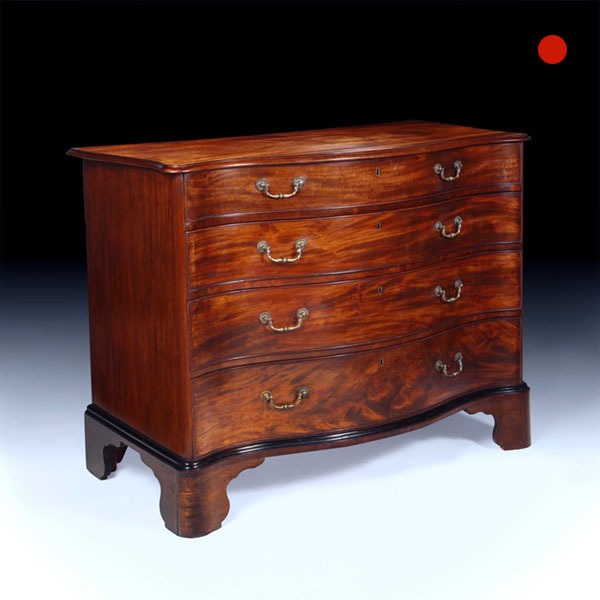
George III Mahogany Serpentine Chest of Drawers
Dating from one of the most famous and highly celebrated periods in English furniture history, now known as the ‘Chippendale period’.
This fine George III mahogany serpentine chest is very much in the manner of Thomas Chippendale.

17th-Century Olive Oyster Lace Box
Charming and original 12” olive oyster lace box, circa 1680-90. It is most likely that this gorgeous piece was commissioned during the short reign of William and Mary (1689-1702). This was a great time in British furniture design with some of the most notable pieces to date being commissioned.
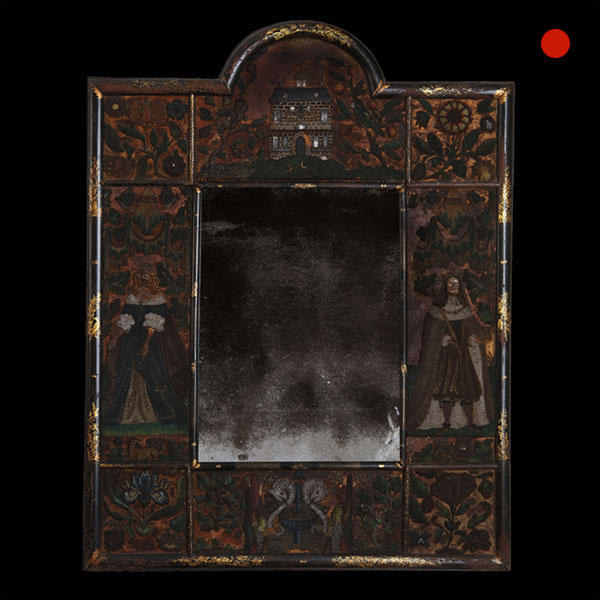
17th-Century Beadwork/Stumpwork Japanned Mirror
Advances in English domestic glass production in the second half of the century coincided with the fashion for stumpwork and resulted in the production of some of the most spectacular examples being produced.
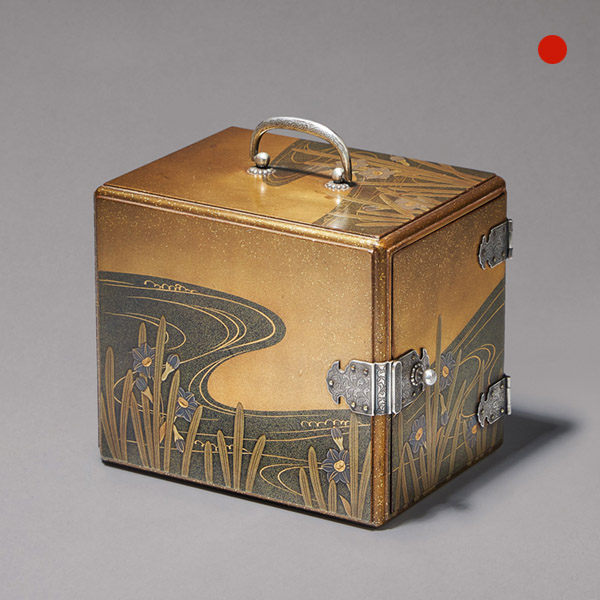
A lacquer kodansu (small cabinet) | Edo period, 19th century
A lacquer Kodansu, Edo period, 19th century Follow UsA lacquer Kodansu Edo period 19th century The rectangular chest with chamfered edges and a hinged door opening to reveal three drawers, all decorated in gold, silver, red and black...
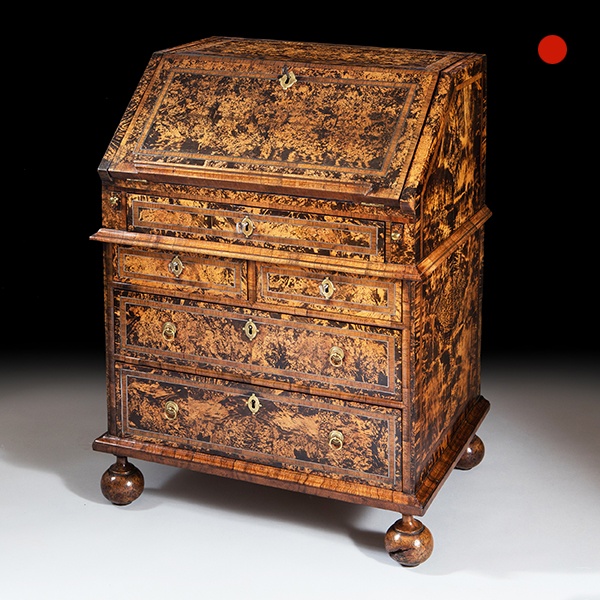
Queen Anne Mulberry Bureau Firmly Attributed to Coxed and Woster, circa 1710 England
Queen Anne Mulberry Bureau Firmly Attributed to Coxed and Woster circa 1710 England SOLD Follow UsQueen Anne Mulberry Bureau Firmly Attributed to Coxed and Woster, circa 1710 England This magnificent Queen Anne 'Mulberry Wood' (field maple) bureau of small proportion...
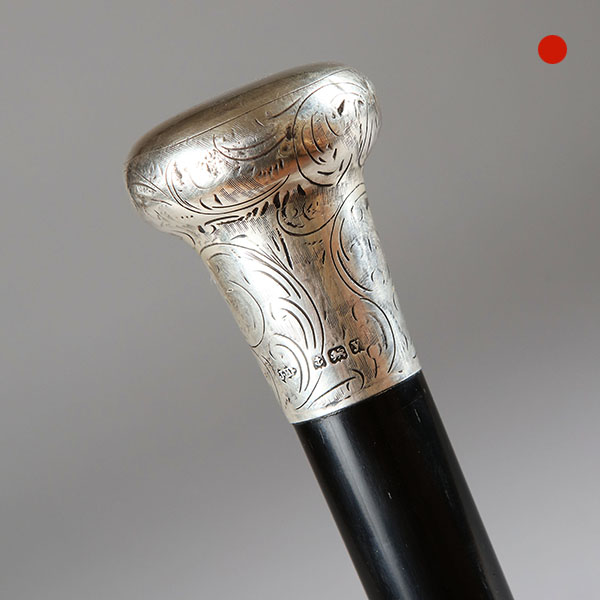
Engraved silver-topped ebony walking cane. Dated 1923 Birmingham
Silver-topped Ebony Walking Cane of outstanding quality and effortless elegance. Tapering ebony cane with a beautifully engraved silver cap.

George III Mahogany Serpentine Chest of Drawers
Dating from one of the most famous and highly celebrated periods in English furniture history, now known as the ‘Chippendale period’.
This fine George III mahogany serpentine chest is very much in the manner of Thomas Chippendale.

17th-Century Olive Oyster Lace Box
Charming and original 12” olive oyster lace box, circa 1680-90. It is most likely that this gorgeous piece was commissioned during the short reign of William and Mary (1689-1702). This was a great time in British furniture design with some of the most notable pieces to date being commissioned.

17th-Century Beadwork/Stumpwork Japanned Mirror
Advances in English domestic glass production in the second half of the century coincided with the fashion for stumpwork and resulted in the production of some of the most spectacular examples being produced.

A lacquer kodansu (small cabinet) | Edo period, 19th century
A lacquer Kodansu, Edo period, 19th century Follow UsA lacquer Kodansu Edo period 19th century The rectangular chest with chamfered edges and a hinged door opening to reveal three drawers, all decorated in gold, silver, red and black...

Queen Anne Mulberry Bureau Firmly Attributed to Coxed and Woster, circa 1710 England
Queen Anne Mulberry Bureau Firmly Attributed to Coxed and Woster circa 1710 England SOLD Follow UsQueen Anne Mulberry Bureau Firmly Attributed to Coxed and Woster, circa 1710 England This magnificent Queen Anne 'Mulberry Wood' (field maple) bureau of small proportion...

Engraved silver-topped ebony walking cane. Dated 1923 Birmingham
Silver-topped Ebony Walking Cane of outstanding quality and effortless elegance. Tapering ebony cane with a beautifully engraved silver cap.
YOU MAY ALSO LIKE
No Results Found
The page you requested could not be found. Try refining your search, or use the navigation above to locate the post.
No Results Found
The page you requested could not be found. Try refining your search, or use the navigation above to locate the post.
